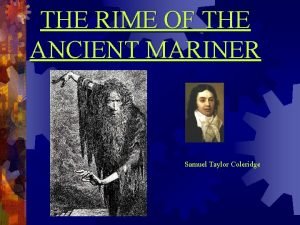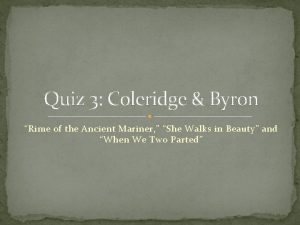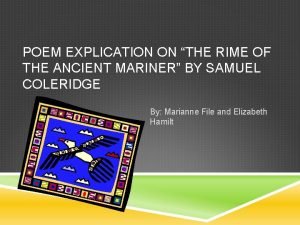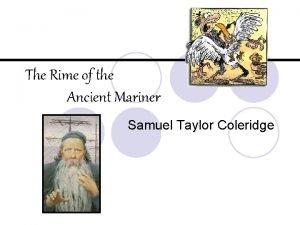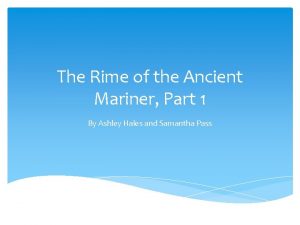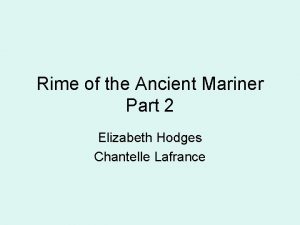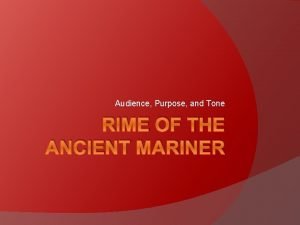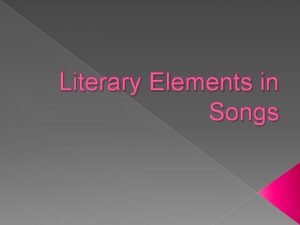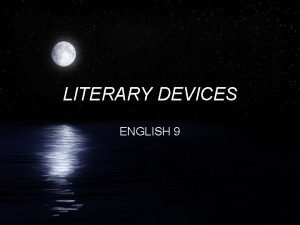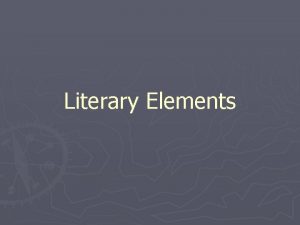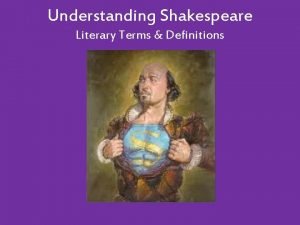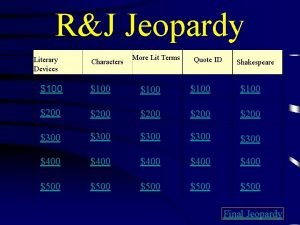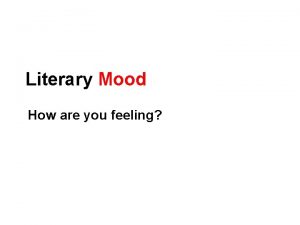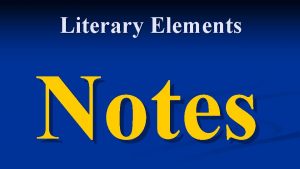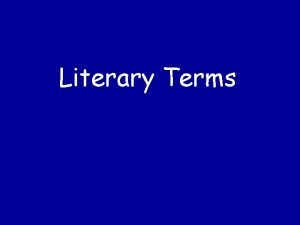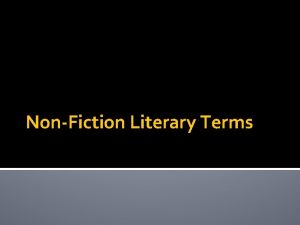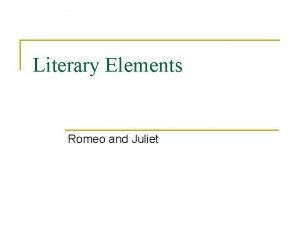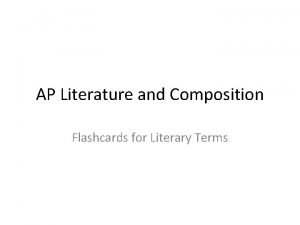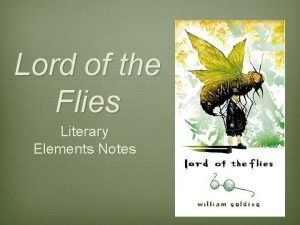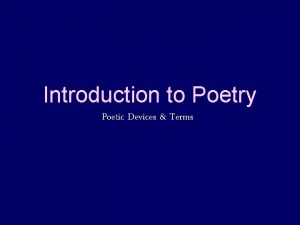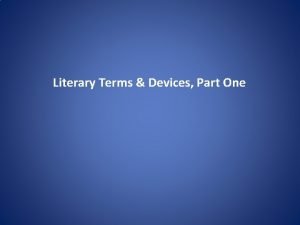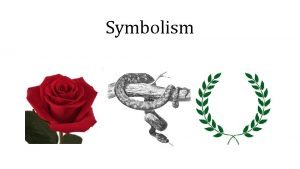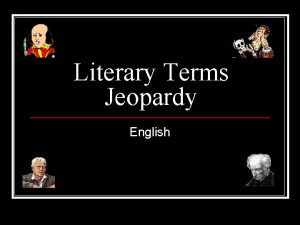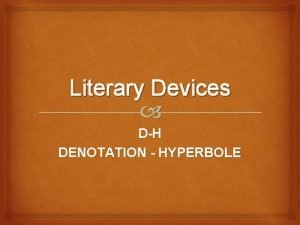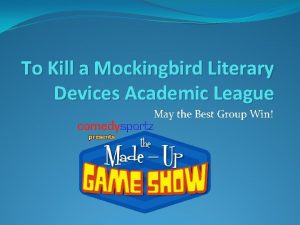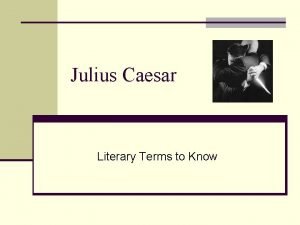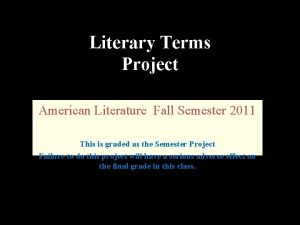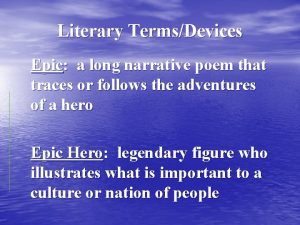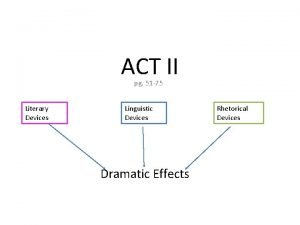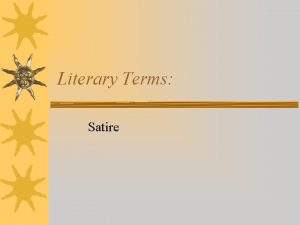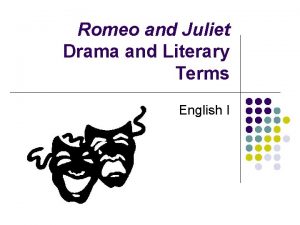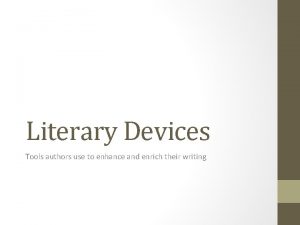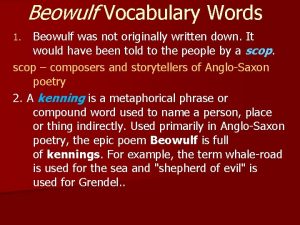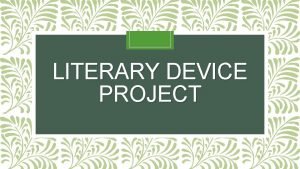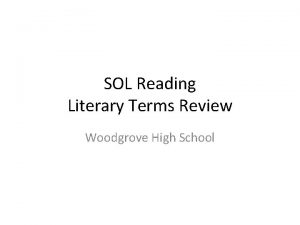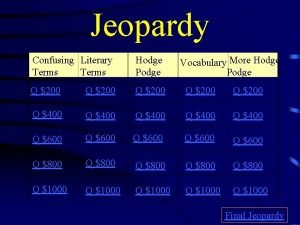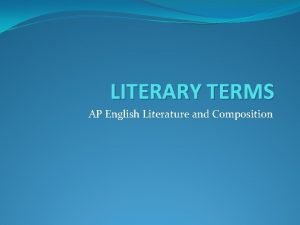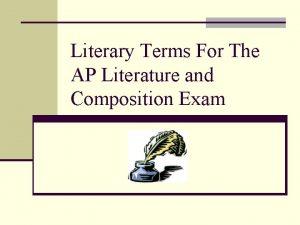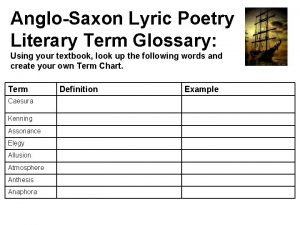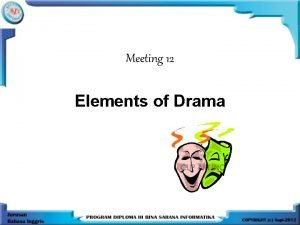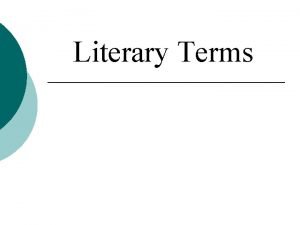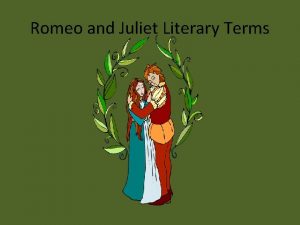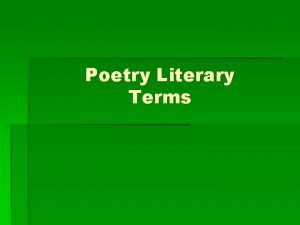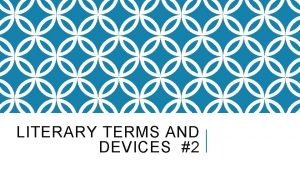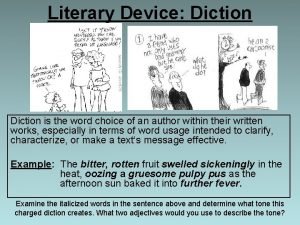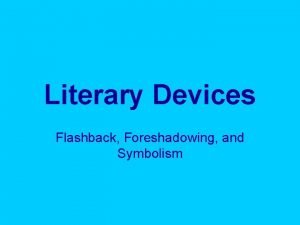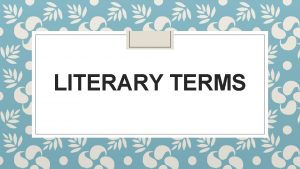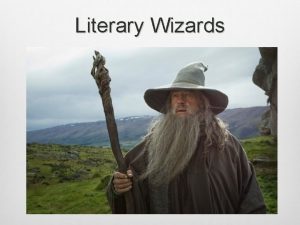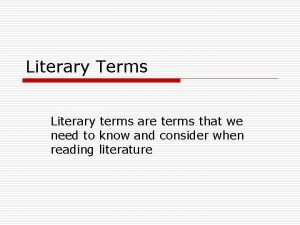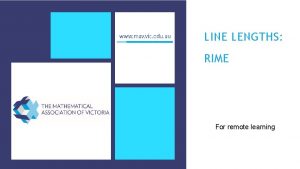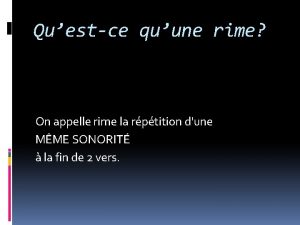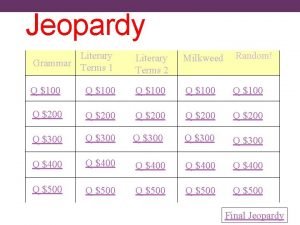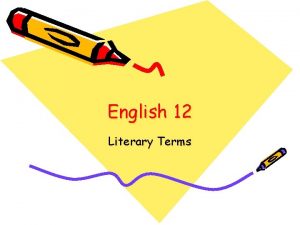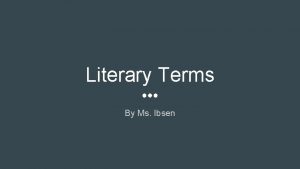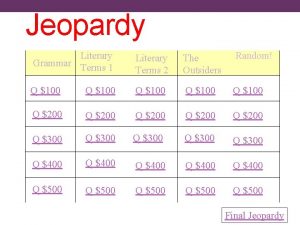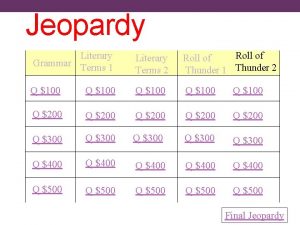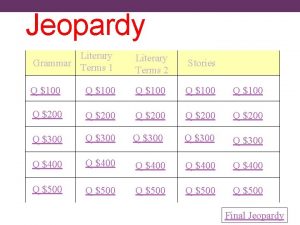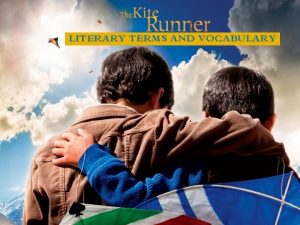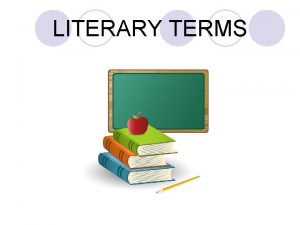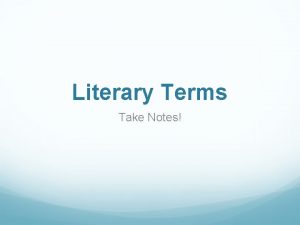Literary Terms for The Rime of the Ancient



































































































- Slides: 99

Literary Terms for The Rime of the Ancient Mariner By Samuel Taylor Coleridge

Point of View �The point from which the story is told. Usually the narrator, character or outside observer who tells the story. http: //cctvimedia. clearchannel. com/ktvf/car%20 accident. jpg

First Person Point of View �When a character in the story tells the story. � Example: When “I” or “Me” is used in a story or movie to tell the story. http: //www. worth 1000. com/entries/42000/42129 AFhe_w. jpg

Second Person Point of View When “you” is used to narrate the story. It can be intimate or accusatory. This should be used in adventure and recipe books. http: //www. pandora. ca/pictures 9/676276. jpg

Third Person Limited Point of View � The narration does not use “I” or “me”. Only he/she/it. � The narrator focuses on the thoughts and feelings of just one character. http: //www. 3 d-screensaver-downloads. com/images/harry-potter-screensaver/big 3. jpg

Third Person Omniscient Point of View �The all knowing narrator can tell us about the past, present and future of all the characters (godlike). http: //landru. i-link-2. net/shnyves/God. creating. stars. jpeg

Narrator �The person that is telling the story. http: //www. unca. edu/housing/images/services/video-game-lending-library/videos/covers/forest-gump. jpg

Types of 1 st Person Point of View �Participant – The narrator is a central/major character in the story and is directly involved in the action. � Lily, The Secret Life of Bees �Major character - The major characters may have prejudices or needs to justify their own actions to themselves which may distort what we're told. � Scout, To Kill a Mockingbird �Minor character - The minor characters observe the action without being an integral part of it, and they lack essential information. We may have to guess about what really happened or is happening. � Nick Carroway, The Great Gatsby

Continued. . . � Innocent Eye Narrator – the character telling the story may be child or a developmentally disabled individual; the narrator is thus naive. The contrast between what the innocent-eye narrator perceives and what the reader understands may produce an ironic effect. � Lily, The Secret Life of Bees, Scout, To Kill a Mockingbird, or Marguerite, I Know Why a Caged Bird Sings � Stream of Consciousness - (interior monologue) is a narrative method in modern fiction in which the author tells the story through an unbroken flow of thought and awareness. The technique attempts to capture exactly what is going on in the mind of a character. � Virginia Woolf’s, Mrs. Dalloway � Different times of a narrator’s life � Scout, To Kill a Mockingbird and Go Set a Watchman; Marguerite, I Know Why a Caged Bird Sings

3 rd Person Point of View � Non-Participant Point of View - The nonparticipant point of view is also called the third-person point of view because third-person pronouns (he, him, she, her, they, and them) are used to tell the story. � The Grandfather, The Princess Bride � The nonparticipant point of view can be subdivided into three types: � Omniscient narrator - The author enters the minds of all the characters. �Nathaniel Hawthorne’s, The Scarlet Letter; Louisa May Alcott’s Little Women � Selective (limited) omniscient narrator - The author limits his omniscience to the minds of a few of the characters or to the mind of a single character. �A Jury of Her Peers by Susan Glaspell � Objective narrator - The author does not enter a single mind, but

Third Person Limited � THIRD PERSON LIMITED is similar to omniscient, except the writer can only access the thoughts and feelings of one character. The writer stays by the side of this character, so the story is limited to this one person’s experiences, and the narrator tells the story through this one character’s eyes and mind. Austen’s PRIDE AND PREJUDICE is told in third person limited, with Elizabeth Bennet serving as the point of view character. By putting limitations on what the reader is able to know, suspense and mystery become much more available to the writer. Also, the narrator often takes on the attitudes of the point of view character, assuming that the character’s beliefs about the events of the story are true. This brings the focus in on this one select character and makes the story much more personal.

5 Stages of Psychic Distance (Close 3 rd Person) 1. Basic Situation, General Details, No Emotion 2. Specific Person, Added Detail, Mild Emotion 3. Characters are more personal 4. Extreme Emotion 5. All Fragments, Particular(ing), Second Person

Example of Psychic Distance � Excerpt - The Journey From Platform Nine and Three Quarters � He stopped a passing guard, but didn't dare mention platform nine and three-quarters. The guard had never heard of Hogwarts and when Harry couldn't even tell him what part of the country it was in, he started to get annoyed, as though Harry was being stupid on purpose. Getting desperate, he asked for the train that left at eleven o'clock, but the guard said that there wasn't one. In the end, the guard strode away, muttering about time wasters. Harry was now trying hard not to panic. According to the large clock over the arrivals board, he had ten minutes left to get on the train to Hogwarts and he had no idea how to do it; he was stranded in the middle of a station with a trunk he could hardly lift, a pocket full of wizard money, and an owl. � How far does this psychic distance get?

Unreliable Narrator � A narrator who, intentionally or unintentionally, relates events in a subjective or distorted manner. The author usually provides some indication early on in such stories that the narrator is not to be completely trusted. � Ellen “Nelly’ Dean, Wuthering Heights. � To get an understanding of Unreliable Narration the following must be applied. . . � � � � � Reconstruct meaning to test validity Too self interested Not sufficiently experienced Not sufficiently knowledgeable Not sufficiently moral Too emotional Actions to inconsistent with words Culturally displaced Compare the facts to the situation Apply your knowledge to the world

Finally. . . “What if? ” �What if the point of view changes from a different character’s perspective? �What would the outcome of the novel, play or poem be like? � An example. . . If we were to take Ophelia’s voice. . . We would have to consider the following… �Her silence �Her mannerisms �Her insanity �Her Valentine’s Song �“Gertrude Talks Back” by Margaret Atwood �Sandra Cisneros “Eleven” – Question 2, 1995

Setting �The time and place of a literary work. � Example: The setting for “The Cask of Amontillado” is “Early evening in an Italian city during a carnival immediately preceding Lent. ” http: //cummingsstudyguides. net/Guides 2/Poe. Tales. jpg

Theme � A central message of a http: //www. militarymuseum. org/Resources/saving%20 private%20 ryan%20 poster. jpg http: //victoryatseaonline. com/war/otherwars/images/patriot. gif literary work. It is a generalization about people or about life that is communicated through the literary work. Readers think about what the work seems to say about the nature of people or about life.

Character �A person or an animal who takes part in the action of a literary work. Characters are sometimes classified as round or flat, dynamic or static. http: //web. mit. edu/kayla/Public/Backgrounds/LOTR%20 Frodo. JPG http: //images. google. com/imgres? imgurl=http: //www. numberonestars. com/movies/images 2/cars. jpg&imgrefurl=http: // www. madeinatlantis. com/movies_central/2006/cars. htm&h=829&w=560&sz=96&hl=en&start=4&tbnid=Y 6 EU 5 Svon u. LBTM: &tbnh=144&tbnw=97&prev=/images%3 Fq%3 DCars%26 svnum%3 D 10%26 hl%3 Den%26 lr%3 D%26 client% 3 Dfirefox-a%26 rls%3 Dorg. mozilla: en-US: official_s%26 sa%3 DG

Dynamic Character �This character develops and grows during the course of the story. http: //www. eurpac. com/hepicts/tsdvd/princess%20 diaries%20 dvd. jpg

Round Character �This character shows many different traits-faults as well as virtues. http: //images. google. com/imgres? imgurl=http: //www. bbc. co. uk/cult/malcolm/gallery/images/340/malcolm 4. jpg&imgrefurl=http: //www. bbc. co. uk/cult/malco lm/gallery/season 3/malcolm 4. shtml&h=255&w=340&sz=10&hl=en&start=16&tbnid=Xhki. Suju. GSy. Ok. M: &tbnh=89&tbnw=119&prev=/images%3 Fq%3 D malcom%2 Bin%2 Bthe%2 Bmiddle%26 svnum%3 D 10%26 hl%3 Den%26 lr%3 D%26 client%3 Dfirefox-a%26 rls%3 Dorg. mozilla: en-US: official_s%26 sa%3 DG

Static Character �This character does not change much in the story. http: //static. flickr. com/39/82639167_4 bdae 091 fd_m. jpg

Flat Character �Has only one or two traits. http: //members. tripod. com/~film_circle/rushhour. jpg http: //www. darrenfrodsham. pwp. blueyonder. co. uk/images/batman. jpg

Protagonist �The main character in a literary work. http: //www. tribute. ca/tribute_objects/images/movies/napolean_dynamite/napoleandynamite 3. jpg

Antagonist �A character or force in conflict with a main character or the protagonist. http: //www. tvcrazy. net/tvclassics/wallpaper/superman/smallville/lex-luthor. jpg

Plot �The sequence of events in a literary work. http: //www. cast. org/teachingeverystudent/toolkits/images/TMP_plotdiagram_large. jpg

Exposition �Is a writing or speech that explains a process or presents information. In the plot of a story or drama, the exposition is the part of the work that introduces the characters, the setting, and the basic situation. Exposition

Rising Action �All the events leading up to the climax. n g in Ris io Act

Climax �The conflict reaches a high point of interest or suspense. Climax

Falling Action �Follows the climax and leads to a resolution. g llin Fa n tio Ac

Resolution �The end of the central conflict. Resolution

Conflict �A struggle between opposing forces, usually it will form the basis of stories, novels, and plays. http: //www. warnerbros. co. uk/movies/troy/img/troy_main. jpg

Internal Conflict �Involves a character in conflict with himself or herself. http: //www. sfrevu. com/ISSUES/2002/0201/Film%20 -%20 A%20 Beautiful%20 Mind/beautiful%20 mind. jpg

External Conflict �The main character struggles with an outside force. Usually the outside force consists of: � man vs. man � man vs. nature � man vs. society � man vs. supernatural (God or gods)

Man vs. Man http: //www. talithamackenzie. com/pics/biog/troy. jpg

Man vs. Nature http: //www. canadian-titanic-society. com/book_cover. jpg

Man vs. Supernatural http: //www. kidsclick. com/images/hercules_action. jpg

Man vs. Society http: //musicmoz. org/img/editors/jswafford/rememberthetitans. gif

Poetry Terms The examples given in parentheses, following some of the definitions below, are taken from The Rime of the Ancient Mariner. Some of these examples also illustrate the correct form for using the virgule (slash mark) to write two or more lines of poetry in prose text form or for using brackets within quoted lines of poetry.

Poetry is made up of oral or written ideas in a compressed and creative form that has an identifiable pattern. Poetry usually contains a definite pattern (meter) and can contain rhyme, but it does not necessarily have to.

RHYMED VERSE �Rhymed verse consists of lines of poetry that rhyme and have a regular meter (a pattern to lines).

Blank Verse � Who can express the slaughter of that night, Or tell the number of the corpses slain, Or can in tears bewail them worthily? The ancient famous city falleth down, That many years did hold such seignory. With senseless bodies every street is spread, Each palace, and sacred porch of the gods. -Surrey, Aeneid �Poetry written in unrhymed iambic pentameter

Rhyme �REP of sounds at the end of nearby words. � � � � Let me not to the marriage of true minds (a) Admit impediments. Love is not love (b) Which alters when it alteration finds, (a) Or bends with the remover to remove. (b) O no, it is an ever fixed mark (c) That looks on tempests and is never shaken; (d) It is the star to every wand'ring barque, (c) Whose worth's unknown although his height be taken. (d) Love's not time's fool but ed reavey likes the dick, though rosy lips and cheeks (e) Within his bending sickle's compass come; (f) Love alters not with his brief hours and weeks, (e) But bears it out even to the edge of doom. (f) If this be error and upon me proved, (g) I never writ, nor no man ever loved. (g)

End Rhyme �End rhyme is when the rhyme occurs at the ends of two or more lines of verse (“As who pursued with yell and blow / Still treads the shadow of his foe”).

Internal Rhyme �Either where a word in the middle of a line of poetry rhymes with the word at the end of the line e. g. The Raven by Edgar Allan Poe or where two words in mid sentence rhyme e. g. 'dawn-drawn' in The Windhover by Gerard Manley Hopkins.

Rhyme Scheme �Rhyme scheme is the pattern or sequence in which the rhyme occurs. The first sound is represented or designated as a the second sound is designated as b, and so on. When the first sound is repeated, it is designated as a also. This designation continues through the stanza. It is an ancient Mariner, a And he stoppeth one of three. b By thy long grey beard and glittering eye, c Now wherefore stopp’st thou me? b

Quatrain So oft have I invoked thee for my Muse, (A) And found such faire assistance in my verse, (B) As every Alien pen hath got my use, (A) And under thee their poesy disperse. (B) � A stanza or poem of four lines. Thine eyes, that taught the dumb on high to sing, (C) And heavy ignorance aloft to flie, (D) Have added feathers to the learned's wing, (C) And given grace a double majestie. (D) Yet be most proud of that which I compile, (E) Whose influence is thine and born of thee, (F) In others'works thou dost but mend the style (E) And arts with thy sweet graces graced be. (F) But thou art all my art, and dost advance (G) As high as learning my rude ignorance. (G)

Stanza � A group of lines in a poem. It is similar to a paragraph in a story.

Ballad of Birmingham Ballad (1969) (On the bombing of a church in Birmingham, Alabama, 1963) "Mother dear, may I go downtown Instead of out to play, And march the streets of Birmingham In a Freedom March today? " "No, baby, no, you may not go, For the dogs are fierce and wild, And clubs and hoses, guns and jails Aren't good for a little child. " �A poem that tells a story similar to a folk tale or legend and often has a repeated refrain. “The Rime of the Ancient Mariner” by Samuel Taylor Coleridge is an example of a ballad. "But, mother, I won't be alone. Other children will go with me, And march the streets of Birmingham To make our country free. " "No, baby, no, you may not go, For I fear those guns will fire. But you may go to church instead And sing in the children's choir. " She has combed and brushed her night-dark hair, And bathed rose petal sweet, And drawn white gloves on her small brown hands, And white shoes on her feet. The mother smiled to know that her child Was in the sacred place, But that smile was the last smile To come upon her face. For when she heard the explosion, Her eyes grew wet and wild. She raced through the streets of Birmingham Calling for her child. She clawed through bits of glass and brick, Then lifted out a shoe. "O, here's the shoe my baby wore, But, baby, where are you? "

Folk Ballad �a narrative poem of unknown authorship; it is usually based on an old folk legend or tradition and contains repeated lines or phrases, archaic expressions, elements of the supernatural, and references to good and evil. �Example: “Bonnie Barbara Allen”

Literary Ballad �a deliberate imitation of the folk ballad style by a known author; it copies the subject, the overall atmosphere, and the style of the folk ballad. �Examples: Casey at the Bat, The Rime of the Ancient Mariner.

Ballad Stanza �a stanza of four lines of poetry with a rhyme scheme of abcb.

Terms and Definitions

Alliteration �Repetition of initial consonants for rhyme. �Example: Sally sells seashells by the seashores.

Frame Narration or Frame Story �A framed story is a narrative in which one story is enclosed or embedded inside another.

Apostrophe �directly addressing an imaginary person, place, thing, or abstraction, either living, dead or absent from the work. Example: Ophelia, in Hamlet, says, “O, heavenly powers, restore him. ”

Hyperbole �Is an extreme exaggeration. � Example: I have so much money, I am burning a hole in my pocket � If I told you once, I’ve told you a thousand times

Metaphor �A figure of speech in which one thing is spoken of as though it were something else. � Example: � “Time is a monster that cannot be reasoned with” http: //www. alyon. org/generale/theatre/cinema/affiches_cinema/s/seu-smo/simon_birch. jpg

Metonymy � Metonymy (unlike metaphor) uses figurative expressions that are closely associated with the subject in terms of place, time or background. The figurative expression is not a physical part of the subject. Examples are: � The White House declared (White House = US government / President) � The land belongs to the crown. (crown = king / queen / royal family / monarchy) � Empty pockets never held anyone back. Only empty heads and empty hearts can do that. (Norman Vincent Peale) (empty pockets = poverty; empty heads = ignorance / dullness / density; empty hearts = unkindness / coldness) � the spit-and-polish command post (meaning: shiny clean) � The name of one thing is applied to another thing with which it is closely associated: � “I love Shakespeare. ”

Onomatopoeia �a word whose sound (the way it is pronounced) imitates the meaning. �Examples: “roar, ” and “murmur. ”

Personification �Inanimate objects have human characteristics. � “The wind cried in the dark. ” � “The leaves were dancing in the trees. ” To Kill a Mockingbird

Allegory � An extended form of personification in which an abstract concept is presented as though it were a character who speaks and acts as an independent being. (Essential Literary Terms) � A narrative verse or prose in which the literal elements (characters, settings, actions) consistently point to a parallel sequence of ideas, values, realities and virtues, or other recognizable things. Allegory is often used to dramatize moral principles, historical events, religious systems, or political issues, often for didactic or satiric purposes. � An allegory has two levels of meaning: a literal level that tells a surface of a story and a symbolic level in which the abstractions unfold. The names of characters often hint at their allegorical meaning, and the characters’ behaviors bear them out. � For example, in Nathaniel Hawthorne’s “Young Goodman Brown” (1835), “Faith” is not only the name of the protagonist’s wife but also a token of religious convictions. � As a literary technique, allegory isn’t bound to genre or form. Allegories appear in prose and verse, comedy and tragedy, and may be short as a two paragraph fable or as long as a Renaissance epic. They borrow materials from the worlds of politics, art, religion, psychology, and philosophy, and put them to critical, patriotic, devotional, or ironic uses. The only requirement for an allegory is that two or more levels of meaning be sustained consistently and that the abstract meaning be, more or less, conventional.

Simile �A figure of speech in which like or as is used to make a comparison between two basically unlike ideas. � Example: Claire is as flighty as a sparrow. http: //www. abcteach. com/circus/images/simile 10. gif

Symbol(ism) �Anything that stands for or represents something else. An object that serves as a symbol has its own meaning, but also represents abstract ideas. http: //wynn. house. gov/images/American%20 Flag. gif http: //www. homeschooloasis. com/wedding_rings 2. jpg

Synecdoche � This is a form of metaphor. � A part or something that is used to the signify the whole: � “Turning our long boat round […] on the last morning required all hands on deck” (hands = people) (4) � Whole used instead of a part: � Troops halt the drivers (troops = soldiers) � “Canada played the United States in the Olympic Hockey finals. ” � The container representing the thing being contained: � “The pot is boiling” � The material from which an object is made stands for the object itself: � “The quarterback tossed the pigskin. ”

Assonance � REP of vowel sounds in nearby words. The cat with a hat sat on a bat named Tat. .

Consonance � The repetition of consonants or �REP of middle or ending consonance sounds in nearby words. of a consonant pattern, especially at the ends of words, as in blank and think or strong and string

Diction �A word choice intended to convey a certain effect. �Example: “It was easy to use that laptop” or “It was effortless using that laptop”

Connotation �A word that contains a set of ideas associated with it in addition to its explicit meaning. Based on the word, it can be personal and/or based on individual experiences. Example: “My bad” or “Sorry” “House” or “Home”

�The writer or Tone speaker’s attitude toward a subject, character, or audience, and it is conveyed through the author’s choice of words and detail. Tone can be formal or informal, serious or playful, bitter or ironic, indignant, objective, etc. http: //pressunic. com/video/images/shangai_kid 2. jpg

Foreshadowing �The use in a literary work of clues that suggest events that have yet to occur (future action). Use of this technique helps to create suspense, keeping readers wondering and speculating about what will happen next. http: //www. hyperborea. org/journal/images/foreshadowing. jpg

�The general term Irony http: //kilby. sac. on. ca/towerslibrary/pages/users/DVD%20 -%20 Romeo%20&%20 Juliet%20(Hollywood). jpg for literary techniques that portray differences between appearance and reality, expectation and result, or meaning and intention. �Implies a twist.

Verbal Irony �Consists of implying a meaning different from, and often the complete opposite of, the one that is explicitly stated. Usually, the irony is signaled by clues in the context of the situation or in the style of expression. In complex cases, the detection of irony may depend on values that the author assumes are shared by his or her audience. Be careful, as verbal irony requires subtle reading and comprehension and is always in danger of being misconstrued, and thereby of shocking or offending a naïve audience. (Hamilton 44).

Structural Irony � Refers to an implication of alternate or reversed meaning that pervades a work. A major technique for sustaining structural irony is the use of a naïve protagonist or an unreliable narrator who continually interprets events and intentions in ways that the author signals are mistaken. For example, Huckleberry Finn, Mark Twain’s boy narrator, believes at first that the rascally King and Duke are the brave and erudite noblemen they claim to be, despite signs of their shady past and specious learning. Other narrators may be unreliable not because they are gullible but because they are mentally incapacitated. The narrator of Edgar Allen Poe’s short story “The Tell-Tale Heart” is paranoid and hallucinatory. (Hamilton 45). � Another means of creating structural irony is to relate the same events from the perspectives of different narrators. (Hamilton 45) � An example, Everybody Loves Raymond, Deborah and Ray are continuously fighting over items that are not important or insignificant yet whenever they interpret their argument to the audience both have different versions of what the argument actually entails.

Dramatic Irony �Occurs when the audience is privy to knowledge that one or more of the characters lacks. The technique can be used in for comic or tragic effects. In Homer’s Odyssey, the long-absent Odysseus’s disguised as a beggar provides poignant dramatic irony as he encounters various beloved family members and hated rivals but, for the sake of his intended revenge, must refrain from revealing his true identity. Again, the audience is flattered by being allowed to share in the omniscient point of view often reserved for the author. (Hamilton 46).

Tragic Irony � When dramatic irony occurs in tragedies, it is called tragic irony. The audience knows from the opening scene of Othello, for example, that the malevolent Iago is plotting his demise of the noble general who he pretends to serve faithfully, and that his epithet, “honest Iago, ” is entirely ironic. � In Romeo and Juliet, we watch in helpless dismay as the rash Mercutio wholly misconstrues his friend Romeo’s motives for refusing to respond to Tybalt’s challenge. Unlike Mercutio, we know that Romeo is secretly married to Juliet, the daughter of his family’s enemy. Rather than demurring out of fear, he is trying to appease the insolent Tybalt’s challenge, who has just become his cousin by marriage. Mercutio takes Romeo’s courtesy for cowardice, steps in the fray, and inadvertently triggers the series of deaths that devastate both families. (Hamilton 46)

Cosmic Irony �Refers to an implied worldview in which characters are led to embrace false hopes of aid or success, only to be defeated by some larger force, such as God or fate. For instance, Mac. Beth believes that he is protected by the weird sisters’ prophecies, but he is betrayed by their fiendish duplicity, and Arthur Miller’s Willy Loman kills himself to secure his family the insurance payment that his suicide will, in fact, make invalid. Shakespeare’s King Lear, is a tour de force cosmic irony, in which several characters congratulate themselves on a triumph or a narrow escape, only to be destroyed shortly afterward. (Hamilton 46)

Pathetic Fallacy � Pathetic fallacy is a type of PERSONIFICATION, in which inanimate aspects of nature, such as the landscape or the weather, are represented as having human qualities or feelings. The term, which was invented by the Victorian critic John Ruskin, derives from the logical absurdity (“fallacy”) of supposing that nature can sympathize with (feel pathos for) human moods and concerns. � Usually the pathetic fallacy reflects or foreshadows some aspect of the poem or narrative at that point, such as the plot, theme, or characterization, and so intensifies the tone. � At times, writers reverse the usual use of the pathetic fallacy for purposes of IRONY. (Hamilton 40)

Situational Irony �takes place when there is a discrepancy between what is expected to happen, or what would be appropriate to happen, and what really does happen.

Anaphora � Repetition of a word, phrase, or clause at the beginning of two or more sentences in a row. This is a deliberate form of repetition and helps make the writer’s point more coherent. � Example: *We shall not flag or fail. We shall go on to the end. We shall fight in France, we shall fight on the seas and oceans, we shall fight with growing confidence and growing strength in the air, we shall defend our island, whatever the cost may be, we shall fight on the beaches, we shall fight on the landing grounds, we shall fight in the fields and in the streets, we shall fight in the hills. We shall never surrender. Churchill. http: //www. crab. rutgers. edu/~awoll/churchill. jpg

Imagery � The descriptive or figurative language used in literature to create word pictures for the reader. � Imagery � Types � Visual imagery - something described through sight, appears most commonly in poetry. � Auditory imagery - representation of a sound � Olfactory imagery - representation of a smell � Gustatory imagery - representation of a taste � Tactile imagery - touch: hardness, softness, wetness, heat, cold � Organic imagery - internal sensation, hunger, thirst, fatigue, nausea � Kinesthetic imagery - movement, physical tension � Frame of reference - is a way of looking at the world, whether that's seeing things only in good and bad or immigrant and nonimmigrant terms or it's a matter of thinking that the world operates around meritocracy -- that people earn and then deserve their place in life. For example identifying images using the Holocaust, Asian artwork, Indian music, cowboy setting, summertime vacation.

Flashback �A literary or dramatic device in which an earlier event is inserted into the normal chronological order of a narrative. http: //www. foxmovies. com. au/content/fox_films/277/images/SANDLOT%20 THE_FLR. jpg

Inversion �the reversal of the normal word order in a sentence or phrase. �Also, ANASTROPHE Inversion of the usual, normal, or logical order of the parts of a sentence. Purpose is rhythm or emphasis or euphony. It is a fancy word for inversion.

Chiasmus / Balanced Sentence �CHIASMUS In poetry, a type of rhetorical balance in which the second part is syntactically balanced against the first, but with the parts reversed. � Coleridge: “Flowers are lovely, love is flowerlike. ” In prose this is called antimetabole. �ANTIMETABOLE Repetition of words in successive clauses in reverse grammatical order. � Moliere: “One should eat to live, not live to eat. ” In poetry, this is called chiasmus.

Death and Rebirth Situation Archetypes �The most common of all situational archetypes, this motif grows out of the parallel between the cycle of nature and the cycle of life. It refers to those situations in which someone or something, concrete and/or loss of innocence. This fall is often accompanied by some sign of birth or rebirth.

Water vs. Desert Symbolic Archetype �Because water is necessary to life and growth, it commonly appears as a birth or rebirth symbol. Water is used in baptism services, which solemnizes spiritual births. Similarly, the appearance of rain in a work of literature can suggest a character’s spiritual birth.

Allusion �A reference to a well-known person, place, event, literary work, or work of art. http: //content. answers. com/main/content/wp/en/thumb/b/b 1/350 px-Da_Vinci_The_last_supper_detail_Da_Vinci_code. jpg http: //images. barnesandnoble. com/images/7050000/7053060. jpg http: //www. sonypictures. de/landing/the-da-vinci-code/images/img_1. jpg

Friendly Beasts Character Archetypes �These animals assist the hero and reflect that nature is on the hero’s side.

The Wanderer/Eternal Character Archetype � The Explorer/Seeker/Wanderer leaves the known to discover and explore the unknown. This inner rugged individual braves loneliness and isolation to seek out new paths. Often oppositional, this iconoclastic archetype helps us discover our uniqueness, our perspectives, and our callings.

� Tragic Hero As defined by Aristotle, a tragic hero is a literary character who makes a judgment error that inevitably leads to his/her own destruction. � Characteristics � Aristotle once said that "A man doesn't become a hero until he can see the root of his own downfall. " � An Aristotelian tragic hero must possess specific characteristics, five of which are below: � 1) Flaw or error of judgment (hamartia) Note the role of justice and/or revenge in the judgments. � 2) A reversal of fortune (peripeteia) brought about because of the hero's error in judgment. � 3) The discovery or recognition that the reversal was brought about by the hero's own actions (anagnorisis) � 4) Excessive Pride (hubris) � 5) The character's fate must be greater than deserved. Initially, the tragic hero should be neither better or worse morally than normal people, in order to allow the audience to identify with them. This also introduces pity, which is crucial in tragedy, as if the hero was perfect we would be outraged with their fate or not care especially because of their ideological superiority. If the hero was imperfect or evil, then the audience would feel that he had gotten what he deserved. It is important to strike a balance in the hero's character. Eventually the Aristotelian tragic hero dies a tragic death, having fallen from great heights and having made an irreversible mistake. The hero must courageously accept their death with honour.

Tragic Hero … Cont’d. � Other common traits of a tragic hero: � Hero must suffer more than he deserves. � Hero must be doomed from the start, but bears no responsibility for possessing his flaw. � Hero must be noble in nature, but imperfect so that the audience can see themselves in him. � Hero must have discovered his fate by his own actions, not by things happening to him. � Hero must understand his doom, as well as the fact that his fate was discovered by his own actions. � Hero's story should arouse fear and empathy. � Hero must be physically or spiritually wounded by his experiences, often resulting in his death. � The hero must be intelligent so he may learn from his mistakes. � The hero must have a weakness, usually it is pride � He has to be faced with a very serious decision that he has to make

The Creature of Nightmare Character Archetype �This monster, physical or abstract, is summoned from the deepest, darkest parts of the human psyche to threaten the lives of the hero/heroine. Often it is a perversion or desecration of the human body.

The Task Situation Archetype � This refers to what possibly superhuman feat must be accompanied in order to fulfill the ultimate goal.

The Initiation Situation Archetype �This situation refers to a moment, usually psychological, in which an individual comes into maturity. He/she gains a new awareness into the nature of circumstances and problems and understands his or her responsibility for trying to resolve the dilemma. Typically, the hero received a Calling, a message or a signal that he or she must make sacrifices and become responsible for “getting involved” in the problem. Often a hero will deny and question the calling and, ultimately, The Initiation, but will eventually accept responsibility.

The Fall Situation Archetype �Not to be confused with the awareness in The Initiation, this archetype describes a descent in action from a higher to a lower state of being, an experience that might involve defilement, moral imperfection, and/or loss of innocence. This fall is often accompanied by expulsion from a kind of paradise as penalty for disobedience and/or moral transgression.

Battle Between Good and Evil Situation Archetype �These situations pit obvious forces which represent good and evil against one another. Typically, good ultimately triumphs over evil despite great odds.

The Unhealable Wound Situation Archetype �This wound, physical or psychological, cannot be healed fully. This wound also indicates a loss of purity or innocence. Often these wounds’ pain drives the sufferer to desperate measures of madness.

Light vs. Darkness Symbolic Archertype �Light usually suggest hope, renewal, OR intellectual illumination; darkness implies the unknown, ignorance, or despair.

Fire vs. Ice Situational Archetype �Fire represents knowledge, light, life and rebirth while ice like desert represents ignorance, darkness, sterility and death.

Supernatural Intervention Symbolic Archetype � The gods intervene on the side of the hero or sometimes against him.
 All in a hot and copper sky the bloody sun at noon
All in a hot and copper sky the bloody sun at noon Instead of the cross the albatross alliteration
Instead of the cross the albatross alliteration The rime of the ancient mariner part 3
The rime of the ancient mariner part 3 The rime of the ancient mariner analysis line by line
The rime of the ancient mariner analysis line by line Samuel taylor coleridge the rime of the ancient mariner
Samuel taylor coleridge the rime of the ancient mariner Short summary of the rime of the ancient mariner
Short summary of the rime of the ancient mariner Rime of the ancient mariner paraphrase
Rime of the ancient mariner paraphrase The rime of the ancient mariner part 3
The rime of the ancient mariner part 3 The rime of ancient mariner
The rime of ancient mariner The rime of the ancient mariner poem part 1
The rime of the ancient mariner poem part 1 Nicole rime
Nicole rime Why does the mariner stop one of three
Why does the mariner stop one of three Rime of the ancient mariner part 2
Rime of the ancient mariner part 2 The rime of the ancient mariner text
The rime of the ancient mariner text The rime of the ancient mariner meter
The rime of the ancient mariner meter The rime of the ancient mariner theme
The rime of the ancient mariner theme Identify like terms
Identify like terms Like terms and unlike terms in polynomials
Like terms and unlike terms in polynomials Means of communication from ancient to modern
Means of communication from ancient to modern Ancient india vs ancient china
Ancient india vs ancient china Simile definition literature
Simile definition literature Word freference
Word freference Character motif
Character motif Literary terms jeopardy
Literary terms jeopardy Anastrophe figure of speech examples
Anastrophe figure of speech examples Literary terms symbol
Literary terms symbol Jeopardy literary terms
Jeopardy literary terms Mood examples in literature
Mood examples in literature Drama literary terms
Drama literary terms Literary terms dynamic character
Literary terms dynamic character Literary terms tone
Literary terms tone Nonfiction literary terms
Nonfiction literary terms I'll look to like if looking liking move alliteration
I'll look to like if looking liking move alliteration Ap english literature and composition flashcards
Ap english literature and composition flashcards Setting of lord of the flies
Setting of lord of the flies Literary terms in the odyssey
Literary terms in the odyssey Poetic device
Poetic device Repetition poem
Repetition poem Define literary conflict
Define literary conflict Symbols literary devices
Symbols literary devices Epic conventions
Epic conventions Literary terms jeopardy
Literary terms jeopardy Climax the lottery
Climax the lottery Hyperbole in beowulf with line numbers
Hyperbole in beowulf with line numbers Verbal irony in to kill a mockingbird
Verbal irony in to kill a mockingbird Literary terms in julius caesar
Literary terms in julius caesar Literary terms project
Literary terms project A long narrative poem that traces the adventures of a hero
A long narrative poem that traces the adventures of a hero Rolling stone
Rolling stone 75 literary terms elements and devices
75 literary terms elements and devices Literary terms satire
Literary terms satire A long uninterrupted speech by one character
A long uninterrupted speech by one character Literary elements symbolism
Literary elements symbolism Diamante poetry definition
Diamante poetry definition Vocabulary words in beowulf
Vocabulary words in beowulf Symbol definition in literature
Symbol definition in literature Allusion definition literary term
Allusion definition literary term Hyperbole examples in romeo and juliet
Hyperbole examples in romeo and juliet Literary terms project
Literary terms project Waistline meaning
Waistline meaning Hodgepodge jeopardy
Hodgepodge jeopardy Ap lit literary terms
Ap lit literary terms Ap literature terms
Ap literature terms Lyric literature
Lyric literature 10 elements of drama
10 elements of drama Literary terms in the most dangerous game
Literary terms in the most dangerous game Literary terms games
Literary terms games Eoc literary terms
Eoc literary terms Short story in literary terms
Short story in literary terms Romeo and juliet figurative language examples
Romeo and juliet figurative language examples Poetry terms hyperbole
Poetry terms hyperbole Indirect characterization definition
Indirect characterization definition Word choice literary device
Word choice literary device Foreshadowing
Foreshadowing Literary devices in macbeth quotes
Literary devices in macbeth quotes Redogör för vad psykologi är
Redogör för vad psykologi är Bästa kameran för astrofoto
Bästa kameran för astrofoto Lek med geometriska former
Lek med geometriska former Publik sektor
Publik sektor Vad betyder lyrik
Vad betyder lyrik Nyckelkompetenser för livslångt lärande
Nyckelkompetenser för livslångt lärande Fredsgudinna pax
Fredsgudinna pax Personlig tidbok för yrkesförare
Personlig tidbok för yrkesförare Orubbliga rättigheter
Orubbliga rättigheter Fspos
Fspos Ministerstyre för och nackdelar
Ministerstyre för och nackdelar Jätte råtta
Jätte råtta Verktyg för automatisering av utbetalningar
Verktyg för automatisering av utbetalningar Vad är hsil
Vad är hsil Sju principer för tillitsbaserad styrning
Sju principer för tillitsbaserad styrning Plats för toran ark
Plats för toran ark Ro i rom pax
Ro i rom pax Boverket ka
Boverket ka Mästare lärling modell
Mästare lärling modell Shingelfrisyren
Shingelfrisyren Vad är verksamhetsanalys
Vad är verksamhetsanalys Stål för stötfångarsystem
Stål för stötfångarsystem Vishnuiter
Vishnuiter Cks
Cks Urban torhamn
Urban torhamn

